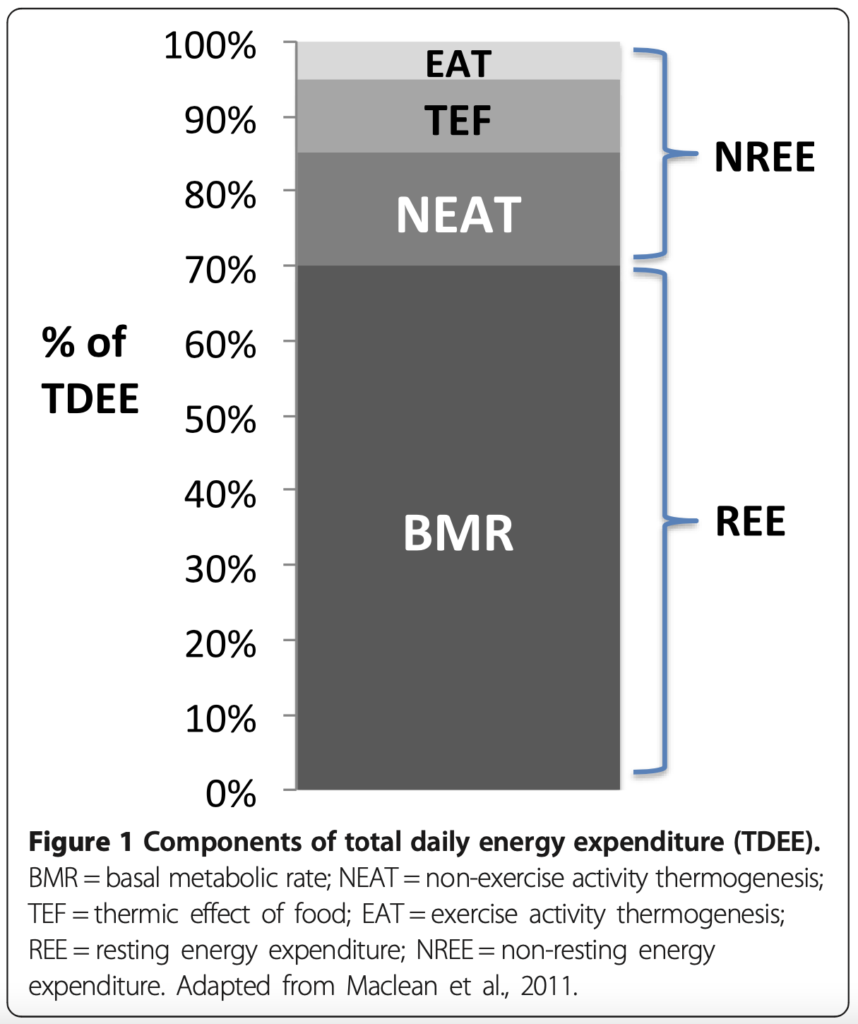Total Daily Energy Expenditure (TDEE)
Your total daily energy expenditure is made up of the following:
BMR: Basal metabolic rate (also often known as basal energy expenditure or resting metabolic rate). This is the energy expended at rest.
NEAT: Non-exercise activity thermogenesis. This is the energy expended for everything we do that is not sleeping, eating or sports-like exercise. (2)
TEF: Thermic effect of food. This is the energy expended in the process of ingesting, absorbing, metabolizing, and storing nutrients from food. (1)
EAT: Exercise activity thermogenesis. This is the energy expended while exercising or playing sport.

Figure 1: Reference 1
To work out your BMR (basal metabolic rate) in step 1, use either the Harris Benedict equation or the Mifflin-St Jeor equation.
Step 1: Harris Benedict Equation
The Harris Benedict Equation was created in 1918. (3)
Men: 66.4730 + (13.7516 x weight in kg) + (5.0033 x height in cm) – 6.7550
Woman: 655.0955 + (9.5634 x weight in kg) + (1.8496 x height in cm) – 4.6756
The Harris Benedict Equation was later revised by Roza and Shizgal in 1984. (4)
Men: 88.362 + (13.397 × weight in kg) + (4.799 × height in cm) – (5.677 × age in years)
Woman: 447.593 + (9.247 × weight in kg) + (3.098 × height in cm) – (4.330 × age in years)
Step 1: Mifflin-St Jeor Equation
The Mifflin-St Jeor Equation was created in 1990 and is more widely used today. (5)
Men: (10 × weight in kg) + (6.25 × height in cm) – (5 × age in years) + 5
Women: (10 × weight in kg) + (6.25 × height in cm) – (5 × age in years) – 161
Step 2: Activity Level
Your BMR only accounts for your energy needs at rest. To determine the calories you expend daily you need to factor in your activity level. This will give you your TDEE (total daily energy expenditure).
To get your TDEE multiple your BMR calories by one of the activity factors below. To do this you need to understand and be honest with how much activity you do. Catrine Tudor-Locke (6) of the University of Massachusetts has been studying pedometer walking in adults for many years and links how our daily steps relate to our physical activity level.
Sedentary – little or no exercise (desk job), less than 5000 steps a day (x 1.2)
Lightly Active – light exercise 1-3 days a week, 5000-7,499 steps a day (x 1.375)
Moderately Active – moderate exercise 3-5 days a week, 7,500-9,999 steps a day (x 1.55)
Very Active – hard exercise 6-7 days a week, 10,000 steps a day (x 1.725)
Extra Active – hard daily exercise & a physical job, 12,500 steps upwards a day (x 1.9)
Example
Using the Mifflin-St Jeor equation.
Age: 32
Weight: 98kg
Height: 182cm
Gender: Male
Activity Level: Lightly active (x 1.375)
BMR = (10 x 98) + (6.25 x 182) – (5 x 32) + 5 = 1962.5 calories
BMR + Activity = 1962.5 x 1.375 = 2698.44 calories
Step 3: Goal
To lose weight: minus (-) 15% of your TDEE calories = 2293.67 calories
To maintain weight: eat your TDEE calories = 2698.44 calories
To gain weight: add (+) 15% of your TDEE calories = 3103.20 calories
References
1) Trexler et al. (2014) Metabolic adaptation to weight loss: implications for the athlete. Journal of the International Society of Sports Nutrition 2014 11:7. Available at: https://www.researchgate.net/publication/260397860_Metabolic_adaptation_to_weight_loss_Implications_for_the_athlete
2) Levine JA. (2002) Non-exercise activity thermogenesis (NEAT). Best Pract Res Clin Endocrinol Metab. Available at: https://pubmed.ncbi.nlm.nih.gov/12468415/
3) Harris JA, Benedict FG. (1918) A Biometric Study of Human Basal Metabolism. Available at: https://www.ncbi.nlm.nih.gov/pmc/articles/PMC1091498/
4) Roza AM, Shizgal HM. (1984) The Harris Benedict equation reevaluated: resting energy requirements and the body cell mass. Available at: https://pubmed.ncbi.nlm.nih.gov/6741850/
5) Mifflin MD, St Jeor ST, Hill LA, Scott BJ, Daugherty SA, Koh YO. (1990) A new predictive equation for resting energy expenditure in healthy individuals. Available at: https://pubmed.ncbi.nlm.nih.gov/2305711/
6) Tudor-Locke, C., Craig, C.L., Brown, W.J. et al. (2011) How many steps/day are enough? for adults. Available at: https://ijbnpa.biomedcentral.com/articles/10.1186/1479-5868-8-79#citeas
I hope this post was of value to you. I’d love to hear your thoughts, please do send me a message on Instagram (simonjamescoaching).
Thank you for reading.
Simon James



